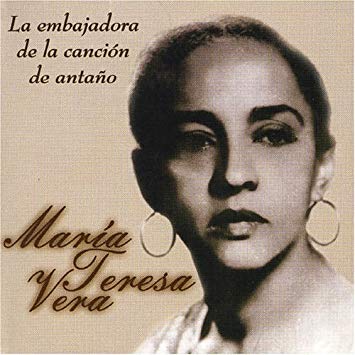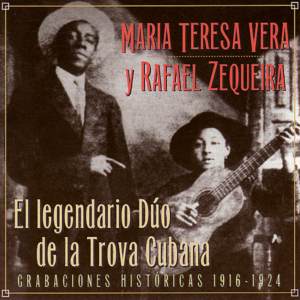 MARÍA TERESA VERA, CANTANTE, COMPOSITORA Y SU LEGADO MUSICAL A CUBA. VIDEOS.
MARÍA TERESA VERA, CANTANTE, COMPOSITORA Y SU LEGADO MUSICAL A CUBA. VIDEOS.
María Teresa Vera, cantante, guitarrista y compositora, nació un 6 de Febrero de 1895 en el pueblo de Guanajay, Pinar del Rio (hoy Artemisa) siendo su voz imprescindible en la historia de la música tradicional de la primera mitad del siglo XX en Cuba.
Este año, en homenaje por su 125 aniversario de nacimiento, el buscador de web Google dedica doodle en reconocimiento a su destacada trayectoria musical.
Su primera obra, el bambuco “Esta vez tocó perder” la compuso en 1914. En 1911, a los 16 años, debutó en el Teatro Politeama Grande, donde actualmente radica la Manzana de Gómez, interpretando la criolla “Mercedes”, de Manuel Corona, quien fuera su autor favorito y que le enseñó a tocar la guitarra.
En 1915 ya aparecía integrando dúo con Rafael Zequeira y tuvo un gran éxito en Cuba y el extranjero.
Fue de las pocas mujeres que en esa época asumió la canción trovadoresca, llamada vieja trova, como expresión de múltiples estilos y géneros: el son, el bolero, la criolla, la habanera, la guaracha y la rumba que comenzaban a dar forma al pentagrama genuinamente cubano…
Varias veces visitó Estados Unidos en donde cumplió presentaciones y grabó canciones para distintas casas disqueras. Fue así que popularizó, por medio de la difusión más importante de aquel momento, las canciones que le hicieron famosa: Mercedes, Longina, Santa Cecilia, y otras de Corona; Mujer perjura, de Miguel Campanioni; rumbas y clavijas ñáñigas, de Ignacio Piñeiro; y bambucos y boleros de Rosendo Ruiz, Patricio Ballagas y Sindo Garay.
Cantó con Zequeira hasta 1924, año en que éste murió; luego hizo dueto con el propio Corona, Higinio Rodríguez y Miguelito García. Integró, junto a Ignacio Piñeiro, el sexteto de sones “Occidente”, agrupación sonera con la que también se presentó en Estados Unidos.
En 1937 unió su singular voz sin vibrato, seca, y cadenciosa a la de Lorenzo Hierrezuelo, en un popular dúo que duró 27 años y un repertorio de cientos de canciones de todos los autores, logrando un estilo para la posteridad.
Entre sus piezas famosas sobresalen “Por qué me siento triste”, “No me sabes querer”, “Yo quiero que tu sepas” y la inmortalizó la criolla “Veinte años” de la inspiración de Guillermina Aramburu, obra incluida en el repertorio de destacados intérpretes nacionales y foráneos.
Son suyos, también, varios boleros y boleros sones compuestos en la década de 1930-1940 con letras de las autoras Guillermina Aramburu y Enma Núñez.
Una de sus mejores composiciones, la habanera Veinte años, ha sido interpretada por varios artistas cubanos; ‘Sólo pienso en ti’, un bolero-son, también es conocido. En 1945 fue contratada por Circuito CMQ para el programa de radio Cosas de Ayer. En la década de 1950, apareció en el programa de televisión El Casino de la Alegría y en la década de 1960 recibió homenajes públicos por su retiro en 1962. Maria Teressa Vera murió en La Habana, el 17 de diciembre de 1965.
Poseedora de una preciosa voz prima en la historia musical cubana esta considerada “Embajadora de la Canción de Antaño” y su legado musical apegado a su raíz deviene patrimonio sonoro de Cuba.
 MARÍA TERESA VERA, SINGER, COMPOSER AND HER MUSICAL LEGACY TO CUBA. VIDEOS.
MARÍA TERESA VERA, SINGER, COMPOSER AND HER MUSICAL LEGACY TO CUBA. VIDEOS.
María Teresa Vera, singer, guitarist, and composer, was born on February 6, 1895, in the town of Guanajay, Pinar del Rio (today Artemisa) being her essential voice in the history of traditional music of the first half of the 20th century in Cuba.
Her first play, the bambuco “This time he had to lose” she composed in 1914. In 1911, at age 16, she debuted at the Teatro Politeama Grande, where the Manzana de Gómez currently lives, performing the Creole “Mercedes” by Manuel Corona, who was her favorite author and who taught her to play the guitar.
In 1915 she already appeared as a duo with Rafael Zequeira and had great success in Cuba and abroad.
It was one of the few women who at that time assumed the troubadour song, called old trova, as an expression of multiple styles and genres: the son, the bolero, the Creole, the Havana, the guaracha and the rumba that began to shape the pentagram genuinely Cuban …
Several times she visited the United States where she performed presentations and recorded songs for different record houses. It was thus that she popularized, through the most important dissemination of that moment, the songs that made her famous: ‘Mercedes’, ‘Longina’, ‘Santa Cecilia’, and others from Corona; ‘Perjura woman’, by Miguel Campanioni; rumbas and pegs ñáñigas, by Ignacio Piñeiro; and bamboo and bolero by Rosendo Ruiz, Patricio Ballagas, and Sindo Garay.
She sang with Zequeira until 1924, the year he died; then she became a duet with Corona himself, Higinio Rodríguez and Miguelito García. She joined, along with Ignacio Piñeiro, the sextet of sones “Occidente”, a sonar group with which she also appeared in the United States.
In 1937 she joined her unique voice without vibrato, dry, and cadences to that of Lorenzo Hierrezuelo, in a popular duo that lasted 27 years and a repertoire of hundreds of songs by all authors, achieving a style for posterity.
Among her famous pieces stand out “Why I feel sad”, “You do not know how to love me”, “I want you to know” and immortalized the Creole “Twenty years” of the inspiration of Guillermina Aramburu, work included in the repertoire of highlights national and foreign interpreters.
They are also her, several boleros and boleros are composed in the decade of 1930-1940 with letters of the authors Guillermina Aramburu and Enma Núñez.
One of her best compositions, the habanera Veinte años, has been performed by a number of Cuban artists; ‘Sólo pienso en ti’, a bolero–son, is also well-known. In 1945 she was contracted to Circuito CMQ for the radio program Cosas de Ayer. In the 1950s, she appeared in the TV program El Casino de la Alegría and in the 1960s she received public tributes on her retirement in 1962. She dies in la Havana, on December 17, 1965.
Possessing a precious premium voice, the composer worked extensively for more than five decades. She is considered Ambassador of the Song of Yesterday ”and her musical legacy attached to her root becomes Cuba’s sound heritage.
Agencies/ RHC/ Guadalupe Yaujar/ Maite González/ Extractos/ Excerpts/ Internet Photos/ YouTube/ Arnoldo Varona/ www.TheCubanHistory.com
THE CUBAN HISTORY, HOLLYWOOD.









